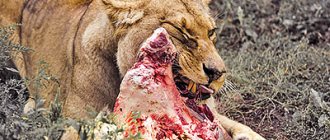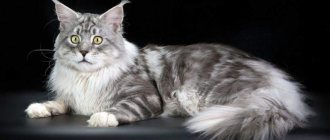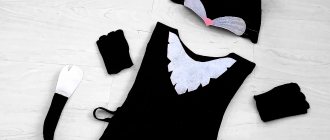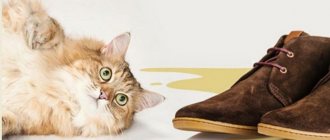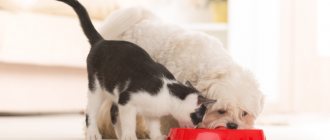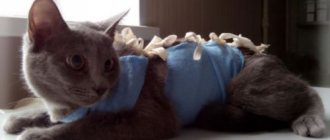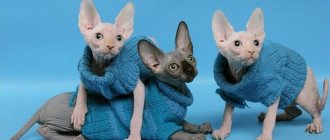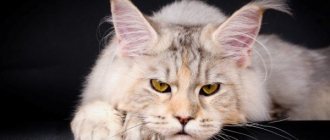Today there are many breeds of dogs and cats for which clothing is not a luxury item, but a necessity. This is especially true for short-haired or hairless animals living in cold climates. This is why many owners think about wardrobe items for their pets. Well, to buy clothes, you need to take measurements of cats and dogs correctly.
Why do you need to measure your cat's height?
Even if your cat leads a purely indoor lifestyle, she will need clothing in cold weather. This applies, first of all, to smooth-haired pets, who are especially cold on autumn days, when the central heating has not yet been turned on in the apartment.
You can sew a cat costume yourself or buy a finished product at a pet store. In both cases, so that the new thing does not turn out to be too small or large, you first need to take measurements from the animal.
In addition, height is measured in purebred animals that participate in exhibitions. Its value serves as the basis for calculating the index of elongation, massiveness, long-leggedness and other parameters of the animal. By comparing these values, a panel of judges determines whether a given specimen meets the required breed standards.
What types of body structure do cats have?
Compared to dogs, domestic cats differ little from each other in shape and size. However, the existing differences distinguish three main types of these animals:
- Undersized . Short-legged cat breeds, the most famous of which is the Munchkin. The paws of these animals are 2-3 times shorter than usual, which is due to the dwarfism gene. Height - up to 20 cm.
- Medium height . Cats with well-developed muscles, slightly rounded heads and medium-sized legs. Height – from 23 to 30 cm.
- Tall . The most famous breeds are Savannah and Maine Coon. Slender, long-legged animals with a narrow chest and wedge-shaped head. Height – up to 45-60 cm.
Normal development of kittens of different breeds
At birth, most kittens weigh between 70-130 g. Maximum weight gain is observed in the first month of life. The average daily gain is 15 g, so by 4 weeks after birth many animals reach 500 g.
You can see detailed changes in body weight from 1 to 12 months in different breeds in the table below.
| Breed | Weight by month (kg) | ||||||
| 1 | 2 | 3-4 | 4-6 | 6-8 | 8-10 | 10-12 | |
| British | 0,56-0,83 | 1,15-1,6 | 1,7-4 | 2,65-5,6 | 3,6-6 | 4-7 | 4,2-8 |
| Scottish | 0,25-0,75 | 0,42-1,8 | 1-3,9 | 2,2-5,5 | 2,3-6,1 | 2,6-6,6 | 2,6-7 |
| Maine Coon | 0,55-0,75 | 1,1-1,6 | 1,6-4 | 2,9-6 | 3,2-7 | 3,8-7,3 | 4-8,7 |
| Don Sphynx | 0,2-0,4 | 0,5-0,8 | 1-3 | 1,3-3,6 | 2,2-5,1 | 2,8-5,7 | 3,2-6,4 |
| Canadian Sphynx | 0,4-0,65 | 0,9-1,3 | 1,5-2,5 | 1,9-3 | 2,6-4,4 | 3,1-4,8 | 3,4-6,8 |
| Persian | 0,37-0,5 | 0,6-1 | 0,95-2,2 | 1,4-3,6 | 2,3-4,3 | 2,8-5,6 | 3,5-6,2 |
| Siamese | 0,23-0,7 | 0,52-1,6 | 1-3,3 | 1,2-4,1 | 1,7-4,6 | 2-5,1 | 2,3-5,6 |
| Siberian | 0,35-0,74 | 0,59-1,45 | 1-4 | 1,6-5,1 | 2,7-5,8 | 3-6,2 | 3,5-7 |
| Russian blue | 0,25-0,74 | 0,45-1,7 | 1-3,9 | 1,7-4,9 | 2,3-5,3 | 2,5-5,5 | 2,5-5,8 |
| Abyssinian | 0,3-0,8 | 0,55-1,5 | 1-3,7 | 1,5-4,5 | 2-5 | 2,3-6 | 2,5-7,5 |
| Ragdoll | 0,28-0,71 | 0,49-1,47 | 1,2-3,67 | 1,7-5,69 | 2,5-6,3 | 3-7,2 | 3,3-7,7 |
| Exotic | 0,25-0,77 | 0,47-1,55 | 1,2-3,5 | 1,7-4,7 | 2,1-5,2 | 2,4-5,7 | 2,8-6,2 |
| Bengal | 0,35-0,56 | 0,64-1,3 | 1,2-3 | 1,7-4,3 | 2,8-5,1 | 3,2-5,6 | 3,3-6,3 |
The table shows that after reaching six months, the rate of weight gain slows down. At this stage, puberty occurs. After this, the weight gain is less significant.
The difference between males and females is also clearly visible, but at first there may be slight deviations within the litter. That is, some girls may be ahead of boys due to a more balanced diet. It may be related to the total number of newborns (lack of nipples) and the degree of milk production of the recently given birth pet.
Separately, we should consider the developmental features of outbred kittens and mixed-breed kittens. First, let's outline their differences:
- Mongrels (outbred). Obtained through uncontrolled and most often natural mating. They do not have documents due to the unknown breed of their parents. They can be born as a result of mating of mixed breeds or other mongrels. In this case, the maximum mixture of a wide variety of breeds can be seen.
- Metis. Obtained by mating animals belonging to different breeds. They do not have documents due to the unofficial nature of such matings. They have more predictable behavior and appearance.
Due to the peculiarities of birth, the norm for mongrels and mixed breeds is very different from general standards. A pet born not according to the rules of selection can take traits from both parents at once. As a result, even here the most reliable method remains visual inspection.
Height or length?
Our smaller brothers walk on four legs, which creates some confusion when taking measurements. What is the difference between a pet's height and its body length?
A cat's height is measured vertically. The withers are taken as the starting point - the border between the cervical and dorsal spine, the highest part of the back. The center of the withers is located at the point between the shoulder blades of the front legs; this place is covered by a particularly dense fold of skin. The cat holds the cat by the withers (in common parlance, by the scruff of the neck) during mating, and the cat drags the newborn kittens.
As for body length, its value is measured in the horizontal direction.
Let's start taking measurements
Measuring the height of a cat is more difficult than measuring the height of a dog. A standard cat will not stand in one place for even a couple of minutes, so to take measurements you will need an assistant to hold the fidget.
The rest is a matter of technique. Place the cat close to the door frame or wall, level with the height of the withers, leave a mark with chalk, and then measure the distance from the floor to the mark made.
Another option is to use a measuring tape. To do this, apply the tape measure itself to the withers, and lower the end of the measuring tape to the floor surface. The resulting value is the height of the animal. If the cat is long-haired, spread the fur to the cat before measuring.
What to do if your pet desperately does not want to stand still for at least a minute, and there is no assistant nearby? Then you can use a trick and measure the animal’s height from a lying position.
If the apartment windows face the sunny side, place a sheet of Whatman paper on the windowsill and let the cat lie down in a place warmed by the sun. When your pet falls asleep, straighten his paws vertically in relation to his body and place marks on the paper. However, when choosing this method, the measurement error increases noticeably.
What about the length?
Along with the height of the animal at the withers, the breed standards must indicate the length of its body. So in our story it would be unfair to ignore this parameter.
Sometimes it is believed that the length of a pet’s body is measured from the tip of the nose to the tip of the tail. However, in fact, the length of a cat with a tail does not say anything about its size, so measurements are taken without taking into account the tail. Even more precisely, the length of the animal’s body is measured from the base of the neck, level with the shoulder joints, to the base of the tail. The measuring tool is the same measuring tape.
Interestingly, data on body length allows us to determine the approximate age of the animal. Here are some approximate indicators for a medium-sized animal:
- newborn kitten – 12 cm;
- kitten aged 2 months – up to 24 cm;
- kitten aged 5-6 months – up to 35 cm;
- adult cat – up to 35 cm;
- adult cat – up to 37 cm.
Stages of growing up cats
Each period of formation is characterized by features of development and growth. If you miss one of the necessary procedures in childhood, it will be impossible to catch up with it in the future.
| Age | Features of development |
| Infancy | The first month of a cat’s life can influence its entire subsequent fate. At this time, you need to ensure that the kitten is not left without mother's milk. |
| (from birth to six months) | |
| Large babies should not be allowed to push smaller ones away from the nipples. The same applies to the period when self-feeding begins - the weak should not give up their portion to the strong. | |
| It is important to treat for blood-sucking and worms. They don't just bother kittens, but affect their overall physical development (including height and weight). | |
| Owners have different attitudes towards vaccinations (after 9 weeks), but it is still better to undergo mandatory vaccination. It will additionally protect kittens during the growth period and increase natural resistance to disease. | |
| In the second month of life, you need to start socializing. During childhood, cats easily get used to human society. It has been observed that the ability to get along with people directly affects life expectancy. | |
| Youth | This is a period of intensive entry into puberty. In cats it occurs from 12 to 15 months, and male cats are usually delayed in growth. |
| (from 6 months to 2 years) | |
| Depending on the breed, cats grow to the age of one and a half to three years. You should not rush with the first offspring, even if the animal’s body is already ready for reproduction - physically they are not yet strong enough to give part of their strength to kittens. This is especially true for girls. Life expectancy is directly correlated with the time of first mating. | |
| During adolescence, proper nutrition is important for cats. To grow, their body needs a maximum diet of nutrients. At this age, cats are very active, play a lot and rarely sit still. | |
| Youth | The period of blossoming and final formation. Now cats use all the health accumulated in childhood, and growth does not take away extra calories from them. |
| (from 2 to 6 years) | |
| This is also the time of entry into the reproductive phase, the birth of offspring and the consolidation of psychological stability. | |
| Maturity | Now the life expectancy of a cat is affected only by nutrition, veterinary care and the good attitude of the owner. |
| (from 7 to 10 years) |
It has been noticed that at an advanced age, the character of most cats changes in a positive direction. They no longer try to dominate and insist on their own, but seem to recognize the owner as their equal.
Petstory app – a service for cat owners
When a pet shows symptoms of deteriorating health, loving owners rush to look for information on the Internet. However, the information that can be gleaned from there often contradicts each other. It is much more convenient to consult with a qualified veterinarian at the first warning signs and get competent advice on what to do next.
To take advantage of this opportunity, install the Petstory mobile application on your smartphone. The service allows you to consult online with experienced veterinarians, and you choose a specific specialist yourself.
In addition, using the application, you can make an appointment at any time at your nearest veterinary clinic. Another useful feature is an interactive map with the location of pet stores, where you can purchase everything you need for your four-legged family member.
Unlike dogs, domestic cats are largely the same when it comes to body size and shape. But there are three main types.
- A type of short cat. Their body structure is dense, their legs are thick, their chest and rump are wide, and their head is round.
- Cats with a developed muscular system: they have medium-sized legs, a medium-sized chest and rump, and a slightly rounded head.
- Cats with a long body: slender, with long legs, narrow chest and rump, long wedge-shaped head.
On average, an adult cat is 30 centimeters high at the shoulders and about 46 centimeters long from the tip of the nose to the tail, while the tail is approximately 30.5 centimeters.
A domestic cat typically weighs about four to five kilograms. It happens, however, that heavyweight cats exceed this weight; record holders reach 30 kilograms or more.
The smallest cats rarely exceed one and a half kilograms.
In most cases, these animals manage (unlike dogs) to stay fit without spending time doing gymnastics or jogging. It is believed that by stretching (and all cats love this activity), they provide themselves with all the necessary exercises to maintain their stature and mobility.
People often ask: why are the body sizes and shapes of cats so different from those of dogs? The domestic cat has a less diverse genotype than dogs; It was bred through selective breeding only a little over a hundred years ago, while the genetic structure of dogs developed over several millennia. When real cats separated from the common line of development with dogs, they developed an almost ideal body structure for sneaking and jumping. The dogs, those hardy runners, remained tied to the ground. An agile cat, on the contrary, can jump to grab a flying bird or climb a tall tree.
Like any hunter, a cat must be fast, agile and silent in its movements. Therefore, the structure of its skeleton, muscles and limbs must meet these goals.
The cat walks using a minimum of energy. Its gait pattern is mostly diagonal, with a front paw stride alternating with a hind paw positioned diagonally. The gait pattern thus looks like this: left hind leg, right front leg, right hind leg, left front leg. The cat's center of gravity is located closer to the head than to the tail, so its forelimbs support the body, and the hind limbs provide it with forward movement.
What are the large breeds of cats?
The modern fashion for large domestic cats dictates the development of large breeds with an exotic appearance. Although, of course, the very word “fashion” is inappropriate in relation to living creatures that live next to us and become our favorites - practically members of the family. Interestingly, most giant cat breeds came to us from the North American continent.
Savannah
The Savannah cat is one of the most unusual domestic cats, a record holder not only in size, but also in cost. This rare exclusive breed was conceived and created not by nature, but by a person who decided to cross a wild animal with a pet. The breed was created in 1986, after a series of unsuccessful experiments in mating the African predator serval with various breeds of cats.
The first generation Savannah (F-1), which has half the blood of a serval, reaches sixty centimeters at the withers and weighs an average of fifteen kilograms. The F-2 generation already has 29 percent wild blood - the dimensions of such a hybrid are reduced to 50–55 centimeters and 10 kilograms, respectively. Each subsequent generation will be even smaller in size, and the fifth generation Swanna is practically no different from an ordinary domestic cat.
Savannah in the third generation no longer looks much like a serval
Finally, the efforts of American breeders were crowned with success - the first offspring were obtained - not only viable, but also reproductive. At the initial stage, pairs of servals consisted of the following breeds:
- Egyptian Mau;
- Ocicats;
- orientals;
- Bengals.
Now, for the sake of genetic stabilization of the hybrid population, the blood of domestic cats is no longer flowing. Matings involve either pairs from two savannahs, or a savannah is crossed with a serval. The bold experiment was aimed at creating an exotic, huge cat with the appearance of a wild predator and an affectionate, docile character.
If in general everything turned out quite well in terms of appearance, then in terms of disposition and behavior, savannahs do not always turn out to be “sofa cushions.” And in cases where the genetics of the predator wins, the exclusive offspring turn out to be unadapted to life in an apartment and even unsafe for humans. Therefore, despite the fact that the breed is the fruit of American selection, in some states of the country Savannahs are still prohibited not only for breeding, but also for keeping - this genetic mix has turned out to be too unpredictable.
The first generation Savannah is often difficult to distinguish from a Serval
The further the savannah is from its wild ancestor, the less animal exoticism it has and the fewer problems there are with keeping it in the house. The first generation Savannah (F-1), which has half the blood of a serval, reaches sixty centimeters at the withers and weighs an average of fifteen kilograms. These cats are tall-legged and have an elongated, predatory body. The F-2 generation already has 29 percent wild blood - the dimensions of such a hybrid are reduced to 50–55 centimeters and 10 kilograms, respectively. Each subsequent generation will be even smaller in size, and the fifth generation Swanna is practically no different from an ordinary domestic cat.
The ideal savannah is very tolerant of people
Nevertheless, the demand for kittens of this breed remains very high. Potential buyers are not deterred by either possible difficulties or the high price - the offspring of the first generations can cost about twenty thousand dollars or even more. This is despite the fact that most animals are sold only sterilized - which, according to the official version of the breeders, should help reduce their potential aggression.
Video: Savannah is the largest and most expensive cat
Maine Coon
As for the origin of this breed, there are several versions that are more reminiscent of legends. Americans are rightfully proud of these magnificent cats and sometimes attribute extraordinary, almost mystical properties to them.
The name “Maine Coon” itself literally translates as “Maine raccoon”, that is, “raccoon from Maine”. One of the common stories is that this breed is a cross between local forest cats and... raccoons. Any zoologist will only laugh at such tales, but take a closer look: in both the appearance and behavior of the Maine Coon there really is something of a raccoon. Many of these cats love, for example, to pick up food with their hands and rinse it in water.
The Maine Coon really does look a bit like a raccoon.
Who has not been called the ancestors of the Maine Coon: wild lynxes, cats of the disgraced Queen Marie Antoinette, and the Persian cat of a certain Captain Coon, who traveled along the coast of North America... Felinologists are still inclined to believe that this aboriginal breed was formed as a result of natural hybridization local wild cats with domestic cats.
Maine Coons were first presented at cat shows back in 1861 - then New York and Boston were conquered by a huge cat with the strange name Captain Jenks from the naval cavalry. But the breed began to gain real popularity only in the middle of the last century and soon became in demand all over the world.
Maine Coon kittens are adorable in any color
These giants are among the largest domestic cats. A seven-kilogram cat is the norm for the breed; cats are usually somewhat smaller. But there are also much larger individuals - some castrated cats reach a weight of fifteen and even eighteen kilograms. But such facts indicate not so much about gigantic size, but about improper metabolism and obesity.
Male Maine Coons are much larger than themselves. The height range at the withers for an adult animal is 25–41 cm; body length can be up to 120 cm, of which the tail accounts for 35–36 cm).
Maine Coon owners especially love to take pictures with their pets in their arms. A couple of simple tricks, plus a little photoshop - and your cat will look like a real monster, striking the imagination of those who are not too knowledgeable about the breed.
With or without Photoshop, the cat is really big
Video: "Raccoon" from Maine
Ragdoll
Ragdolls have been known as a breed since the sixties of the last century, and since then this unusual breed has gained a huge number of fans. Indeed, it is difficult to remain indifferent to these strange cats who know how to relax to the point of being a “rag.” Its name was coined to match the breed: Ragdoll is translated from English as “rag doll.”
But such a fluffy “doll” has very respectable dimensions: cats grow up to eighty centimeters in length and weigh up to seven kilograms, cats are even larger - up to a meter in length and ten kilograms in weight.
"Ragdoll" literally translates to "rag doll"
Oddly enough, there is no reliable information about the origin of the breed. The generally accepted version states that ragdolls originated from three well-known breeds:
- Persian;
- Angora;
- Burmese.
According to another version, the ancestor of the breed was a pregnant cat who was saved after she was hit by a car. In her litter, kittens were born that had the unique ability to completely relax.
Take care of your ragdoll from a young age - this is a very gentle and impressionable creature
Such a quality, pleasant for the owners, can turn into disaster for the animal itself - the ragdoll does not know how to group at all and land in a jump on all four paws, like other cats. Therefore, falling even from a small height is fraught with injury, especially since these cats grow to decent sizes - up to eight to ten kilograms in weight. Redolls are insensitive to pain, and therefore injury in them may not be immediately noticed.
Given these risks, as well as the ragdoll's propensity for dysplasia and heart disease, owners should treat their pets with great care. These funny cats love their owners touchingly and are particularly impressionable. Their fur is soft, pleasant, tangles little and hardly sheds.
Video: Ragdoll - a rag doll?
Chausie
Chausie (Shausie or Houseie) is one of the largest, rarest and most expensive cats in the world. It was bred quite recently by American breeders. Breeding chausie requires a lot of practical experience and deep theoretical knowledge - only professionals can do it. This primarily explains the small number of Chausies and their high price - the average cost of a kitten is ten thousand dollars.
The less wild blood there is in a chausie, the smaller its dimensions
A cat of this breed can weigh up to fifteen kilograms, female cats are somewhat smaller and therefore lighter. Animals of the first generation have an average height of 55 centimeters (like a French bulldog), but taller individuals are also found. Like the Savannah, the Chausie is a hybrid of wild and domestic animals: the wild reed cat House and our usual “purrs” “participated” in the breed.
The breed was registered with the international felinological association TICA only in 2013, after which it received the right to be presented at exhibitions as a new breed.
The coat of the Chausie cannot be confused with any other breed.
The Chausie's coat is completely unique: short, elastic to the touch, shiny and very thick. According to the standard, it can be only three colors:
- ticked tabby;
- ticked silver;
- black.
At the same time, only black tips of the ears and tail are allowed, no matter the color - just like the wild parent of this cutie. Like jungle cats, chausies love water, swim and dive well, and are very fond of fish. Only natural food or special grain-free food is suitable for them - the chausie’s stomach is simply not able to digest the grain component.
And why are there no fish in this bath?
Video: Chausie - exotic smart girl and beauty
Ragamuffin
This breed is perhaps the most loving among big cats. The Ragamuffin is a real giant, the usual weight of an adult cat is from eight to nine kilograms. The height at the withers of a male is forty centimeters, females are five to seven centimeters lower. The paws are strong, thick and high. Due to the fluffy fur, the animal seems even more voluminous.
And it’s especially touching when such a large animal shows amazing tenderness and affection towards a person. The creators of the young breed even “invented” a special coat for these cats - unusually pleasant to the touch, soft and silky, in many ways reminiscent of rabbit fur; I want to pet her all the time.
The American-bred breed was officially recognized internationally only at the beginning of 2011. To breed the Ragamuffin, breeders crossed Ragdolls with ordinary outbred cats.
The ragamuffin's fur just asks: pet me!
The goal of felinologists was to improve the original breed, the ragdoll, and create a breed that is not prone to stress and hereditary diseases. In addition, the new breed required a wide variety of colors and a special quality of wool. But the ragamuffins adopted their wonderful character and a lot of other wonderful qualities from their predecessor, the ragdoll.
The breed is very young and is just beginning to gain popularity in Europe. Neither in Russia nor in other countries of the post-Soviet space there are yet any breeding nurseries engaged in breeding ragamuffins. If you want a baby of this charming breed, you will have to purchase it abroad, where the price of a Ragamuffin baby starts from five hundred dollars.
Video: Ragamuffin - the friendly giant
Siberian cats
The Siberian breed was perhaps the most popular in our open spaces, and it is no coincidence that it is called “a cat from childhood.” Is the cat fluffy? This means it’s Siberian, that’s what those who didn’t particularly delve into felinological complexities thought in large numbers until recently. But the widespread and seemingly well-known breed turned out to be very, very mysterious.
The Siberian cat is a mystery of our felinology
Where did Siberian cats come from anyway? There are at least two versions about this. The first is the simplest: Siberians formed on their own, as a result of spontaneous matings of wild forest and domestic cats. The second version claims that the breed was the result of a lot of work by domestic breeders with natural material - the main breeding centers were located in Moscow, St. Petersburg and Riga.
We see the best fruits of such work today in the Siberian breed, which conveys the brutal image of a forest animal:
- heavy type;
- strong backbone;
- volumetric chest;
- strong rounded paws;
- wide set of ears;
- oval eye shape;
- magnificent coat - thick and long.
Siberians have such a huge variety of colors that most other breeds can envy, but the “forest” colors are the most valued. All these wonderful features are complemented by large dimensions - the average weight of a cat is eight kilograms. Cats are more graceful, they weigh six to a maximum of seven kilograms. The legs of an adult animal are very powerful, but short, and the length of the body together with the tail reaches ninety centimeters.
The Siberian cat harmoniously combines power and grace
Siberians received their first standard only in 1989. This is truly a folk breed - an aboriginal animal of the Russian North, which has a corresponding character; Siberian cats are sincere and open, friendly, inquisitive and sociable. At the same time, they are full of self-esteem, unobtrusive and self-sufficient. And, of course, the famous Siberian health was and remains an integral advantage of the breed.
Video: true Siberian - a cat from childhood
Norwegian forest
The Norwegian Forest Cat is a universal favorite not only among the Scandinavians; The bright, charismatic animal has gained popularity and well-deserved recognition throughout the world. Man did not take any part in the creation of this indigenous breed, and all the efforts of the breeders are aimed at preserving and developing the best qualities of the Norwegian Forest, which is also known under the names Wegie or Scottkat.
Ancient legends tell that the “parents” of this mysterious cat were... snow, frost and the Norwegian forest. One way or another, it was precisely in these circumstances that the image of one of the most interesting cat breeds, its disposition, extraordinary endurance and good health was formed. Norwegians are very proud of their “signature” breed - cats, whose description is very similar to modern ones, were heroines of folk tales and even friends of pagan gods.
Norwegians say that the first representatives of the breed were so harsh that they had to be kept in cages
Wild animals from the wild forest have long since come to human homes, diligently helping him in the fight against rodents and preserving the harvest. The harsh conditions of the Sèvres shaped both the unique appearance of this cat and its strong character. However, over many years of living close to people, the Norwegian’s wild temperament has noticeably softened.
The size and body proportions of Norwegians are similar to Siberians, but in their historical homeland there are also larger individuals - some males reach twelve kilograms and almost a meter in body length (including tail).
Wild color remains the most popular color among Norwegians
Norwegians, unlike other large breeds, are not at risk of obesity - they are extremely active even in old age and have an enviable metabolism. Centuries-old natural selection has provided the cat with excellent health and strong immunity; Even the factor of human intervention in the breed has not yet been able to significantly worsen anything in this regard.
They have reliable, strong bones and healthy joints, which, unfortunately, remains rare among big cats. And this despite the fact that the Norwegian forest ones are very massive, and sometimes there are very heavy specimens, weighing up to ten kilograms. The size of the cat is visually increased due to its magnificent fur coat - very thick and long, with water-repellent properties. The color palette is very diverse, but the most popular is still the wild color, which best fits the image of the Norwegian forest cat.
Even a newborn Norwegian kitten already has very thick and beautiful fur.
The ancient aboriginal breed received official status relatively recently - the Norwegians were the first to be recognized by FIFe in 1977. Since then, the breed has been recognized by all major international felinological organizations.
Video: Norwegian cat is a forest dweller in your apartment
Characteristics of large breeds
Cats are very intelligent animals, and large breeds are well aware of their strength and impressive size. Therefore, they need less human protection and behave confidently and self-sufficiently. Of course, each breed has its own set of “family” behavioral qualities:
- savannahs and chausies can exhibit the temperament of a wild animal;
- Maine Coons are impressive and friendly;
- Siberian and Norwegian cats are independent and self-sufficient;
- Ragamuffins and Ragdolls are affectionately attached to humans.
But in any case, one of the main tasks of a responsible breeder who cares about the breed is such a breeding strategy so that the result is the production of animals that are tolerant of humans.
The slightest manifestations of aggression, by and large, should be considered a breed defect. For large and strong cats, this rule becomes extremely important - especially when breeding hybrid animals, in the genotype of which there is a large proportion of the blood of a wild predatory animal.
How to determine the size of a cat's clothing correctly
To correctly determine the size of clothing, the cat is measured. You will need a tailor's measuring tape. If this is not available, use a piece of non-stretchable twine. Due to its short length and inflexible material, a ruler is not suitable.
The measuring tape may show incorrect results when the markings are not applied correctly (a common defect in measuring tools purchased from the Chinese marketplace). Or the tape has stretched or shrunk during use.
Before taking measurements, you need to check the accuracy by comparing the measurement with a school ruler (preferably a Soviet model - at that time all measuring instruments were checked for measurement accuracy).
Famous giant cats, interesting facts
A representative of the Maine Coon breed entered the pages of the Guinness Book of Records due to its body length of 123 cm.
Maine Coons are often caught doing an interesting activity where they move their paws through the water. Some cats drink water by scooping it up with their paws.
Maine Coons are easy to train and follow dog commands: they bring a stick and sit on command.
A cat named Trouble, a representative of the Ashera breed, was also included in the Guinness Book of Records for body length at the withers - 48 cm. At the same time, its weight is very modest - only 9 kg, but it is this that allows the cat to perform complex tricks and move gracefully.
Representatives of the Ashera breed are marked with the designations F1-F7, which is typical for all interracial breeds. The higher the number, the less wild blood the cat has. Hybrids F1-F3 are recommended for aviary keeping. Cats with a low percentage of Serval blood can be kept indoors.
Chartreux are quite intelligent and easy to train. Some pets bring slippers to their owner and know how to open doors.
Male Siberian cats help females cope with their offspring and devote a lot of time and attention to them.
Turkish Vans love to climb on eaves, balconies, and sit on doors.
The main difference between the British cat and other large breeds is that it matures earlier . Already in one year the animals reach their maximum size. In addition, the British are famous for their faithful service to the state and are appointed to the position of the country's main rat-catchers. The whole of Great Britain was heatedly discussing the event when a cat named Larry left his post.
How to take measurements
When a cat sits or lies, the spine changes length due to deflection or twisting. Clothing for a cat is designed for movement, so measurements are taken after placing the animal.
It is better to measure together. The owner calls the cat, holding a treat in his palm. The palm of the other hand gently supports the stomach, preventing the animal from sitting down.
At this time, the assistant measures:
- the length of the back from the withers to the beginning of the tail (not the end of the body);
- neck circumference (the tape is placed in the middle);
- chest volume (widest point);
- volume of the abdomen (when the cat is expecting kittens, or the pet is well-fed).
Common clothing models are blouses with an elongated back or blankets with a hole for paws without sleeves. When you plan to purchase items with sleeves and legs, the circumference (volume) of the paws is measured.
- The cat stands on four legs, head slightly raised (standard stance).
- The tape wraps around the front legs at chest level just behind the limbs.
- To measure the hind legs, the tape is run parallel to the floor from the level of the groin towards the tail.
- If trousers are purchased, measure the length of the leg from the root of the tail to the desired length (usually the hock).
Clothes for kittens are purchased for growth. It is better to check the measurement table for this breed, which records growth by month. Or purchase clothes by adding up to 4 cm for movement.
size table
Manufacturers conventionally divide all cat breeds into large, medium and small (L, M, S), and then make a breakdown in increments of 3-5 cm, referring to the control measurement of neck girth. Before purchasing, it is worth checking whether the table includes allowances for loose fitting - after all, the cat does not need tight-fitting clothes.
A couple of cm are added to the measured home values for freedom of movement of the animal, then the size is determined from the table.
Important: the choice of size also depends on the type of fabric. If the control measurements with an increase were obtained on the border of two sizes, choose the smaller one when the fabric stretches well (for example, knitted fabric, lycra, jeans with elastane).
If the table determines the size of the cat, and the planned purchase is a jumpsuit worn on four paws, additionally measure their girth.
Before paying for clothes in a pet store, ask the seller about the elasticity of the materials, if necessary, add a couple of centimeters for movement.
How much should an adult cat weigh: table by age and breed
As noted above, weight gain continues until approximately 1.5-2 years. From this moment on, it stabilizes, so the owner can simply hold it.
The table below shows the weight norms for male cats by age and breed.
| Breed | Weight, kg) | |
| Males from 1.5 to 8 years | Females from 1.5 to 8 years | |
| British | 5-8 | 3-6 |
| Scottish | 4-7 | 3-5 |
| Maine Coon | 8-12 | 4,6-7,5 |
| Don Sphynx | 5-7 | 3,5-4 |
| Canadian Sphynx | 5-7 | 3,5-4 |
| Persian | 4-6,2 | 3-5 |
| Siamese | 4-5,6 | 3-4 |
| Siberian | 6-9 | 3,5-7 |
| Russian blue | 3,5-5,8 | 3-4 |
| Abyssinian | 4-7,5 | 3-4,5 |
| Ragdoll | 7-10 | 4-6 |
| Exotic | 4-6,2 | 3-5 |
| Bengal | 5-7 | 3,5-4,5 |
When the animal reaches 8 years of age, it is classified as elderly. The processes in his body slow down. Most of what you eat is stored as fat, and due to reduced activity, muscle mass noticeably decreases. As a result, a pet that meets the above standards may look much more well-fed. This is due to the fact that fat is always lighter than muscle. This feature of the body once again confirms the advisability of a visual inspection.
It is also worth mentioning the relationship with castration and sterilization. After surgery, animals often weigh more than normal. The reasons here are the same as with aging: a slowdown in metabolism and a decrease in usual activity.
Shoe size
To find out which shoes are suitable for a cat, you need to take standard measurements of the length and width of the “feet”. The easiest way is to put your pet on a piece of paper and trace the front and back tracks. Afterwards, in a calm environment, without torturing the animal, you can determine the size of the shoes.
Important: paws, in most cases, differ in size from each other, so you should not rely on single readings.
Clothing for a cat is not a whim of the owner, but a necessity: hairless breeds are cold, short-haired ones need warmth when they are acclimatizing or sick. To prevent the fur from becoming electrified, when choosing clothes for a cat, preference is given to natural fabrics with a small synthetic content.
